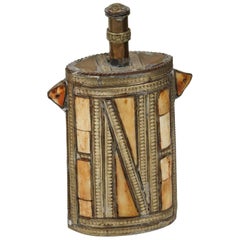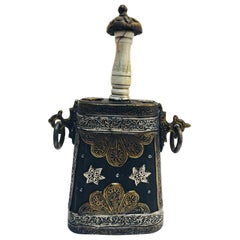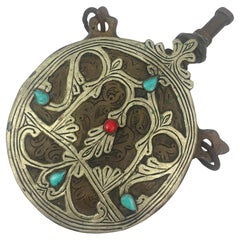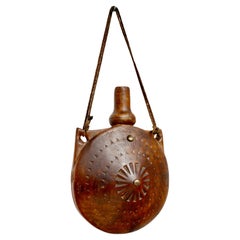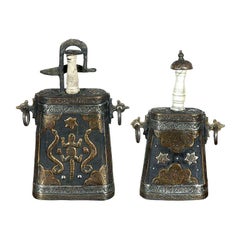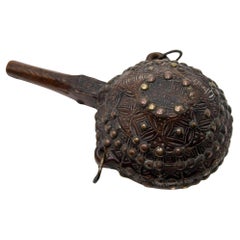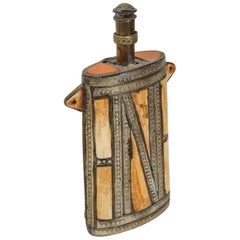Berber Flask
Early 20th Century Moroccan Folk Art Decorative Boxes
Brass
Vintage 1920s Moroccan Moorish Tobacco Accessories
Brass, Tin
20th Century Moroccan Folk Art Decorative Boxes
Brass
Early 20th Century Moroccan Islamic Decorative Boxes
Brass
Antique Late 19th Century Moroccan Folk Art Tribal Art
Brass
Vintage 1920s Moroccan Folk Art More Folk Art
Brass, Tin
Antique Late 19th Century Moroccan Folk Art Decorative Boxes
Brass, Bronze
Recent Sales
20th Century Moroccan Tribal Decorative Boxes
Brass
People Also Browsed
Late 20th Century Japanese Japonisme Jewelry Boxes
Wood, Lacquer
Vintage 1930s American Art Deco Commodes and Chests of Drawers
Brass
Vintage 1960s American Mid-Century Modern Beds and Bed Frames
Brass
Late 19th Century Symbolist Figurative Paintings
Canvas, Oil
2010s South African Brutalist Side Tables
Copper, Steel
2010s Italian Modern Chandeliers and Pendants
Metal, Brass
Vintage 1930s English Art Deco Vanities
Mirror, Walnut
21st Century and Contemporary American Benches
Cherry
20th Century Peruvian Spanish Colonial Wall Mirrors
Glass, Mirror, Giltwood
Mid-20th Century Yemeni Islamic Arms, Armor and Weapons
Metal
Early 20th Century Moroccan Moorish Tapestries
Silk
Vintage 1950s Italian Modern Vanities
Glass, Mirror, Maple
Vintage 1920s Arms, Armor and Weapons
Agate, Silver
Antique Late 19th Century Moroccan Moorish Tray Tables
Brass
Antique 19th Century Beds and Bed Frames
Wood
Early 20th Century Moroccan Moorish Side Tables
Hardwood
Materials: Brass Furniture
Whether burnished or lacquered, antique, new and vintage brass furniture can elevate a room.
From traditional spaces that use brass as an accent — by way of brass dining chairs or brass pendant lights — to contemporary rooms that embrace bold brass decor, there are many ways to incorporate the golden-hued metal.
“I find mixed metals to be a very updated approach, as opposed to the old days, when it was all shiny brass of dulled-out silver tones,” says interior designer Drew McGukin. “I especially love working with brass and blackened steel for added warmth and tonality. To me, aged brass is complementary across many design styles and can trend contemporary or traditional when pushed either way.”
He proves his point in a San Francisco entryway, where a Lindsey Adelman light fixture hangs above a limited-edition table and stools by Kelly Wearstler — also an enthusiast of juxtapositions — all providing bronze accents. The walls were hand-painted by artist Caroline Lizarraga and the ombré stair runner is by DMc.
West Coast designer Catherine Kwong chose a sleek brass and lacquered-parchment credenza by Scala Luxury to fit this San Francisco apartment. “The design of this sideboard is reminiscent of work by French modernist Jean Prouvé. The brass font imbues the space with warmth and the round ‘portholes’ provide an arresting geometric element.”
Find antique, new and vintage brass tables, case pieces and other furnishings now on 1stDibs.
Finding the Right Decorative Objects for You
Every time you move into a house or an apartment — or endeavor to refresh the home you’ve lived in for years — life for that space begins anew. The right home accent, be it the simple placement of a decorative bowl on a shelf or a ceramic vase for fresh flowers, can transform an area from drab to spectacular. But with so many materials and items to choose from, it’s easy to get lost in the process. The key to styling with antique and vintage decorative objects is to work toward making a happy home that best reflects your personal style.
Ceramics are a versatile addition to any home. If you’ve amassed an assortment of functional pottery over the years, think of your mugs and salad bowls as decorative objects, ideal for displaying in a glass cabinet. Vintage ceramic serveware can pop along white open shelving in your dining area, while large stoneware pitchers paired with woven baskets or quilts in an open cupboard can introduce a rustic farmhouse-style element to your den.
Translucent decorative boxes or bowls made of an acrylic plastic called Lucite — a game changer in furniture that’s easy to clean and lasts long — are modern accents that are neutral enough to dress up a coffee table or desktop without cluttering it. If you’re showcasing pieces from the past, a vintage jewelry box for displaying your treasures can spark conversation: Where is the jewelry box from? Is there a story behind it?
Abstract sculptures or an antique vessel for your home library can draw attention to your book collection and add narrative charm to the most appropriate of corners. There’s more than one way to style your bookcases, and decorative objects add a provocative dynamic. “I love magnifying glasses,” says Alex Assouline, global vice president of luxury publisher Assouline, of adding one’s cherished objects to a home library. “They are both useful and decorative. Objects really elevate libraries and can also make them more personal.”
To help with personalizing your space and truly making it your own, find an extraordinary collection of decorative objects on 1stDibs.
